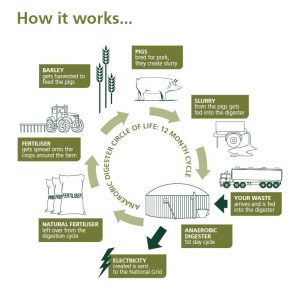The Process
 The pig slurry and feedstocks are fed into a digester (which is a 2500m3 tank) where under anaerobic conditions i.e. in the absence of oxygen, bacteria will breakdown the material and produce a methane rich gas. The quantities of each feedstock used are determined by the methane richness of the biogas produced. The temperature of the digester is maintained between 38oC and 40oC which is the optimum temperature for the bacteria to live and reproduce therefore it is the optimum temperature for the production of methane rich biogas.
The pig slurry and feedstocks are fed into a digester (which is a 2500m3 tank) where under anaerobic conditions i.e. in the absence of oxygen, bacteria will breakdown the material and produce a methane rich gas. The quantities of each feedstock used are determined by the methane richness of the biogas produced. The temperature of the digester is maintained between 38oC and 40oC which is the optimum temperature for the bacteria to live and reproduce therefore it is the optimum temperature for the production of methane rich biogas.
The feedstocks used are utilising local meat processing wastes from abattoirs including DAF sludge which is sludge from the Dissolved Air Flotation treatment of waste water generated in the abattoir. Potentially maize silage, fish processing wastes and chicken feathers could be used to produce electricity at the site but in the first instance they are slurry and meat processing wastes.
The gases produced by the bacteria rise up through the slurry. When the gas reaches the top it is caught in the roof space which has a PVC membrane to trap the gas. The gas is drawn off by the generator engines to produce electricity.
About 15 percent of this electricity is used to run the facility and the remainder is exported to the national grid. As well as electricity the engines also produce hot water. The heat is captured and used to heat the digester to the desired temperature. The heat is also neutralised for the pasturising process. Thus, no fossil fuels are used in the process giving a totally renewable energy. The system was supplied by Weltec Biopower Germany. There have always been very good and environmental reasons for using AD Technology because of its well recognised potential to confer multiple benefits:
Reduction of Emissions of Methane to the atmosphere (23 times more powerful then co2 by diverting bio degradable materials from landsill sites and treating manures).
Potential to manage wastes locally, reducing transport movements and emissions.
Convert Nutrients into Organic Waste to plant available form, replacing mineral fertilizers which consume fossil fuels.
Not sure if your waste could be turned into a resource?
We’ll analyse your waste and give you a free rapid assessment to see if you can start saving money with BioGask. Give us a call!

